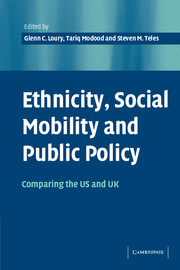Book contents
- Frontmatter
- Contents
- List of figures
- List of tables
- List of contributors
- Acknowledgements
- Introduction
- Part I Historical overviews
- Part II Informal social networks
- 4 Ethnicity as social capital: community-based institutions and embedded networks of social relations
- 5 Intergenerational mobility and racial inequality in education and earnings
- 6 Social integration and social mobility: spatial segregation and intermarriage of the Caribbean population in Britain
- 7 Ghettos and the transmission of ethnic capital
- 8 Family formulation in multicultural Britain: diversity and change
- Part III Formal structures
- Part IV Political institutions and processes
- Part V Normative analysis
- Author index
- Subject index
- References
6 - Social integration and social mobility: spatial segregation and intermarriage of the Caribbean population in Britain
Published online by Cambridge University Press: 22 September 2009
- Frontmatter
- Contents
- List of figures
- List of tables
- List of contributors
- Acknowledgements
- Introduction
- Part I Historical overviews
- Part II Informal social networks
- 4 Ethnicity as social capital: community-based institutions and embedded networks of social relations
- 5 Intergenerational mobility and racial inequality in education and earnings
- 6 Social integration and social mobility: spatial segregation and intermarriage of the Caribbean population in Britain
- 7 Ghettos and the transmission of ethnic capital
- 8 Family formulation in multicultural Britain: diversity and change
- Part III Formal structures
- Part IV Political institutions and processes
- Part V Normative analysis
- Author index
- Subject index
- References
Summary
Introduction
This chapter deals with the social, economic, and spatial mobility of the Caribbean and other ethnic populations in Britain between 1948 and 2000. It draws comparisons, on the one hand, with the Indian, Pakistani, and Bangladeshi populations and other recent ethnic minorities in Britain, and on the other hand, with the African-American population in the United States. The Caribbean population is taken as the best available comparator for the African-American population in the UK/US analysis. The thrust of the chapter is that the British Caribbean male population is economically disadvantaged but socially integrated, while the Caribbean female population has a bimodal distribution, being both socially and economically more marginalized than Caribbean males in its lower levels but economically more advantaged in its upper levels.
One of the illuminating, if tendentious, generalizations about ethnic minorities in Britain has been to divide them into the Jewish and the Irish models of settlement. In broad terms, the Irish model is seen as having been more blue-collar, manual-labour dominated, council-house-tenured, and inner-city located, while the Jewish model is seen as white-collar, self-employed, owner-occupied and suburban. The Irish model (pace Mary Hickman, this volume) is similar to and convergent with the population as a whole. The Jewish model has been seen as pluralistic, maintaining its cultural distinctiveness despite economic integration. As with most broad generalizations, there are many exceptions, but it nevertheless is an instructive framework.
- Type
- Chapter
- Information
- Ethnicity, Social Mobility, and Public PolicyComparing the USA and UK, pp. 178 - 203Publisher: Cambridge University PressPrint publication year: 2005
References
- 39
- Cited by



